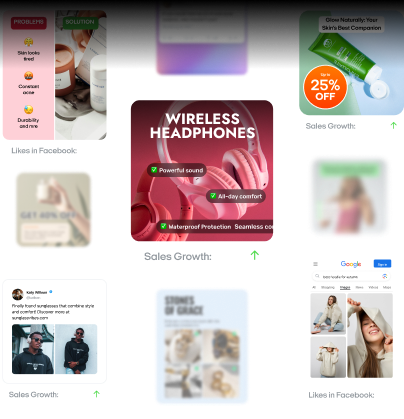Static ads vs. Video ads: Detailed comparison and 6 tips for smarter ad choices
Confused about when to use static or video ads? Zeely AI compares both formats in depth and shares six expert tips to help you make smarter, results-driven ad decisions.
If your ads aren’t converting, the real culprit might be the ad format, not the platform. You’re comparing static ads with video ads because both impact your ROI, CPM, and audience perception. The wrong format risks losing engagement, while the right one drives better results.
A static ad uses a single image and concise text. You get faster production, lower cost per mille, and a clear message that’s easy to absorb. Because it’s simple, you can test offers quickly and fine-tune them for different segments of your marketing funnel.
A video ad depends on motion, audio, and a touch of storytelling. It’s ideal for brand awareness and can spark a higher engagement rate, but it calls for more resources and planning.
Statista found that autoplay videos with sound rank as the most annoying online ads. Nearly half the respondents cited them as the worst. That doesn’t mean all video ads fail, though. Focus on user-initiated or skippable formats. Keep your audience involved without pushing them away.
You may see a stronger conversion rate with video ads, especially if you align them with each stage of your funnel. But static ads excel at quick tests and direct offers that need minimal creative effort. So, look at your creative strategy and your audience before choosing.
By comparing AI static ads vs video ads, you’ll see which format fits your campaign goals. Either choice can boost CTR and keep your audience engaged, as long as it matches what you want to achieve. The best approach is the one that speaks to your audience and delivers on your ROI.
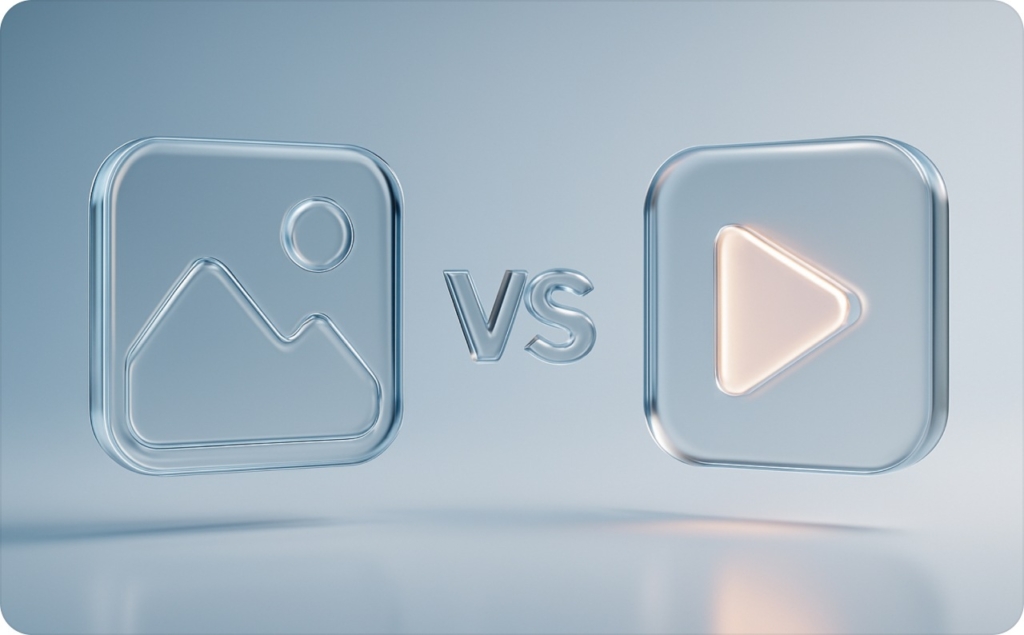
Breaking down static and video ads
A static ad uses one image and concise text to lower production costs. You’ll spot these image ads across Meta, the Google Display Network, and mobile apps. They’re easy to adapt for paid social ads, making them ideal for direct promotions or rapid testing.
AI video ads use motion, sound, and storytelling. You’ll see in-stream video on YouTube or TikTok, where dynamic formats thrive. Though it demands more scripting, editing, and attention to media placement, it can boost brand awareness and engagement rates if you have a solid creative strategy and resources.
Static ads give you quick, low-cost outreach. Video ads let you tell richer stories. Your choice depends on your budget, audience preferences, and campaign context. Used well, both formats can amplify results across digital media channels.
The core traits that differentiate static ads
A strong static ad hooks your audience in seconds. You rely on a single image and short text, which lowers production costs and speeds up deployment. This format suits rapid campaigns and tight budgets. You can shift visuals and messaging fast whenever you need a new test or direct offer.
Key features
- Low production time for quick deployment
- Immediate clarity with minimal design clutter
- Easy A/B testing for faster optimization
- Rapid platform adaptation across Meta, mobile banners, and the Google Display Network
When you place static ads on Meta, mobile banners, or the Google Display Network, you deliver instant clarity. This simplicity makes A/B testing easy. SaaS and B2B brands use static for lead generation, while retailers drive quick sales. You can also expand your creative strategy with thumbnails or light motion graphics.
What sets video ads apart
A compelling video ad needs to grab viewers in the first few seconds. You rely on motion, sound, and careful pacing to elevate your product or service. By using an immersive format, you can often drive higher brand awareness and deeper engagement.
If you pick the right aspect ratio, for instance, 9:16 on TikTok or Instagram Reels, or square on Meta, you’ll meet platform expectations and keep people watching longer.
Key features
- Strong storytelling through sight and sound
- Variable aspect ratios for TikTok — vertical, Instagram Reels — vertical, or Meta — square
- The ideal length is under 30 seconds for better retention
- Effective hooks within 3–5 seconds to grab attention
Many fashion and lifestyle marketers run how-to clips or behind-the-scenes reels. B2B teams use video to break down complex solutions. With a strong creative strategy, video ads enrich social feeds and streaming platforms, generating a richer brand experience that can spark conversions.
The strengths and weaknesses of each format in practice
You’re not just choosing a visual style when you compare static ads to video ads. You’re deciding how to allocate budget, grab attention, and boost ROI. Each format fits different stages of the marketing funnel, meets unique performance goals, and follows its creative lifecycle.
| Ad format | Pros | Cons |
| Static ads | Fast and low-cost production, clear, simple messaging, easy to retarget and scale, fast offer testing | Lower engagement, limited storytelling, creative fatigue if not refreshed |
| Video ads | Higher engagement and brand lift, strong storytelling potential, advanced retargeting options | Longer production time, higher costs, creative risks with pacing or audio |
Upsides and downsides of static ads
Static ads rely on a single image or graphic. They thrive on cost efficiency and rapid deployment. Because there’s no motion or sound, your headline and main visual stand out easily.
If you’re running on a budget under $1,000 per campaign, static ads help you validate offers quickly. You can also reuse elements, like overlays, for short video intros later. However, a single image may not pop in video-heavy feeds, and the same static design grows stale if you don’t refresh it regularly.
For example, you launch a static “10% Off” promo. Conversions spike, then fall. You change the image and headline, and conversions rise again. This highlights creative ad fatigue — cheap and easy doesn’t mean set-and-forget.
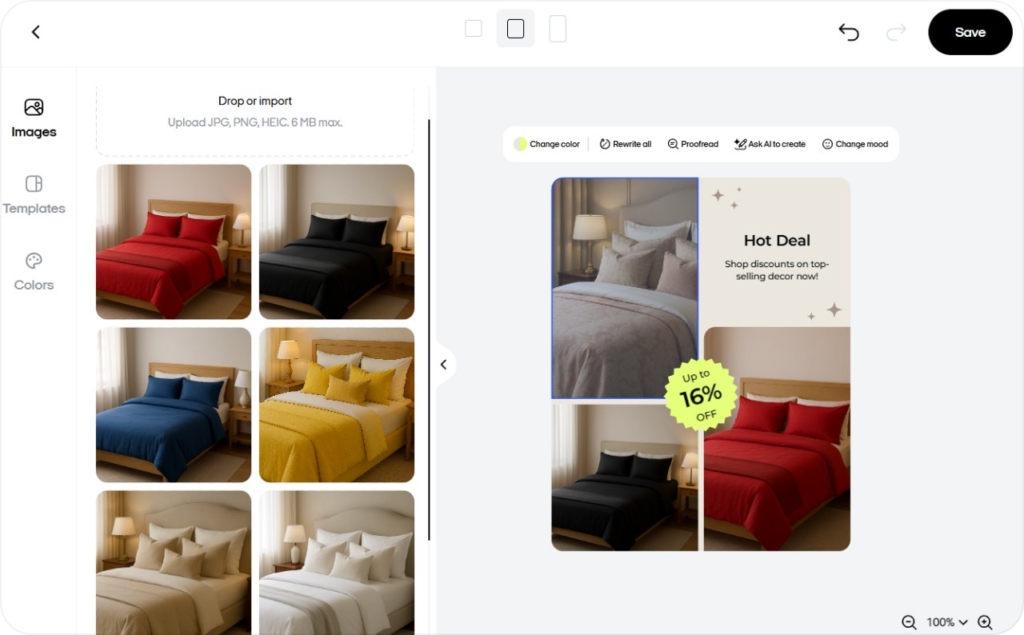
Upsides and downsides of video ads
Video ads offer higher engagement by using motion, sound, and emotional storytelling. They often shine at TOFU, but you can boost mid-funnel efforts too if you need to explain more.
Production timelines tend to be longer — filming, editing, and approvals all demand more skill or budget. In some contexts, particularly with formats like Amazon’s Sponsored Brands video, the engagement multiplier can reach as high as 17.7 times that of static ads. If pacing or audio flops, though, you risk wasting spend.
Platforms like TikTok, YouTube, or Instagram love short video content. Video remains key to TikTok, especially with research showing a 19% lift in conversions when advertisers mix images and video. Just tailor the ratio cuts on channels properly.
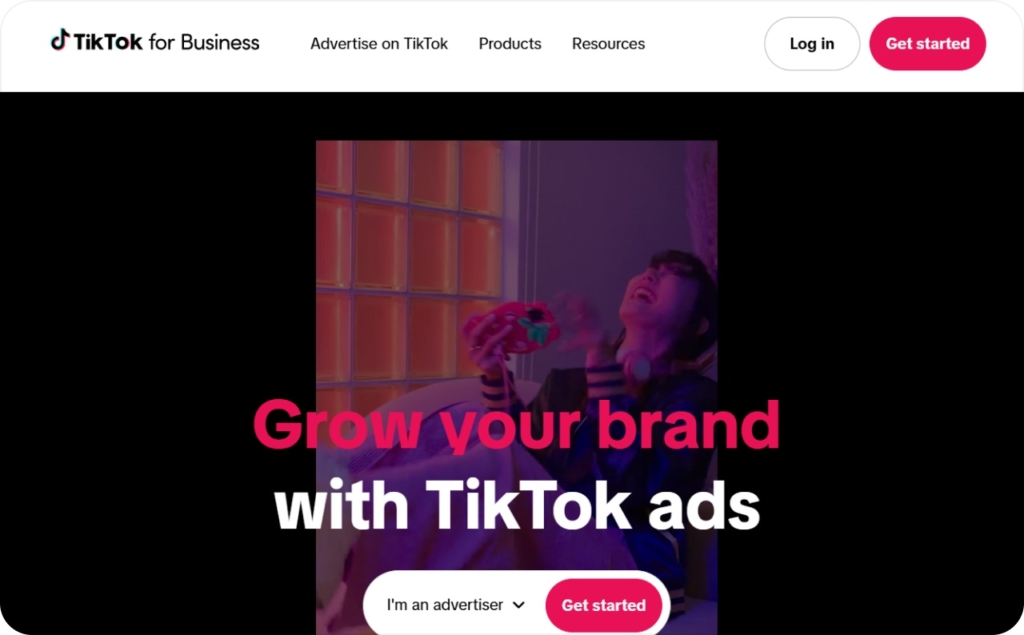
Which format is best for higher engagement and lower ad spend costs
If you need quick, low-cost outreach or fast A/B tests, lean on static ads. If you want a deeper impact or brand-driven storytelling, use video ads at the top of your funnel. Then shift to static ads for BOFU conversions and simpler offers. That way, you pair static’s speed with video’s engagement.
Track metrics like CTR, CPC, and overall engagement to find what resonates. By refining your mix and testing each format across channels, you’ll unlock stronger results and a better ROI.
How static and video ads stack up in real performance data
Comparing static ads to video ads isn’t just about appearance. It’s about their CTR, CPM, and conversion rate. Conflicting or outdated data can make you hesitant to spend. That’s why we’re diving into quantitative insights on impressions, engagement, and cost differences, so you can make a performance-driven choice.
Remember, factors like audience targeting, platform algorithms, and your creative strategy will all shape how each ad format turns out. Always run A/B tests to confirm what resonates with your specific crowd.
A look at reach, impressions, and engagement trends
Video ads typically earn more audience interaction. Platforms like Facebook and TikTok often boost video reach, which means higher impression counts. Still, static ads remain valuable for quick offers or retargeting, especially if you need instant loading and a direct call-to-action.
Outbrain’s data reveals that native videos can reach a 50% completion rate and 60% viewability. Static ads may get fewer likes or shares, but they still build brand recall. If you want emotional resonance, aim for video. If your goal is a frictionless user journey, static often does the trick.
Comparing CTR and conversion power by format
Video ads hold attention longer and let you place a timely call-to-action. That’s why they tend to deliver higher click-through rates. Static ads, however, can work well at the bottom of the funnel if your audience trusts your offer. A good Facebook CTR is approximately 2%.
A campaign by Biteable recorded 480% more clicks on a video ad than a static version using the same copy, plus 498% more likes. Yet video demands more resources, so if you’re short on time, static may be the safer route.
Balancing CTR and CPC is crucial. If video spikes costs, see if the extra engagement justifies it. For direct offers or retargeting, static ads often deliver steady results without big creative hurdles.
Cost, CPC, and ROI insights from real campaigns
Budget decisions always matter. Video ads can be pricier to produce and often raise CPM, but they also build a stronger ROI if brand awareness is your goal. Facebook static ads usually show lower CPM rates, which is $13.75 on average. It appeals to lean budgets or direct sales, even if the click volume is smaller.
In the same Biteable case, the video hit a better ROI. It was 497% cheaper per click and 280% cheaper per lead than the static counterpart, costing $1.19 per click versus $7.11 for the image. This highlights how the right video can outperform static on cost-efficiency.
If creating videos strains your resources or if static ads already meet your funnel objectives, weigh that carefully. Look at your cost per purchase or conversion to see if spending more on video is worth it.
Putting it all together
Set your KPIs first. If you aim for higher CTR or deeper engagement, go with video ads, especially for top-of-funnel brand awareness. If you need lower CPC and quick-turn offers, try static ads for retargeting or direct sales. A blend of both is often best, particularly on TikTok.
Check CPM, conversion rate, and cost per lead to confirm which format matches your goals. In the end, performance-efficient campaigns come from ad creative testing, not guesswork, so keep experimenting until you find the winning mix.
Where and when each format works best in your funnel
Mapping static ads and video ads to your marketing funnel makes the decision easier. Start with video ads at the top to spark interest, then switch to static ads at the bottom to close the deal. This funnel-based approach avoids creative fatigue and balances emotional pull with direct response.
If you want immediate impact, static ads can work best. If you need deeper engagement, video ads shine. It’s common to blend both for maximum reach. Keep your goals and user journey in mind at every step.
Static ads fit direct offers and budget-friendly campaigns
Static ads are quick to produce, cost less, and make A/B testing simple. They fit remarketing or high-frequency retargeting, where you swap images often to avoid ad burnout. A direct offer or discount is ideal for this format because you don’t need complex visuals to succeed.
Video ads shine at the awareness and engagement stage
Video ads support brand awareness, emotional storytelling, and broader engagement. Their dynamic visuals and extended attention span can spark viral reach, but they also demand more production time, higher costs, and a careful campaign rollout strategy.
They rely on motion, sound, and visual flair to grab attention. Short clips can showcase demos, testimonials, or behind-the-scenes content. Focus on a strong hook in the first few seconds, and avoid long runtimes unless you’re on YouTube or a similar channel that supports extended viewing.
Platform-specific tips
- Meta: Blend short video ads with in-feed static retargeting
- TikTok: Use vertical video with fast cuts, and add static ads for returning visitors
- YouTube: Use video ads in-stream or as bumper spots, then layer static GDN retargeting
- Instagram: Test Reels for short video content, then reinforce offers with feed-based static ads
If you need immediate conversions or simple offers, lean on static ads. For greater engagement or stronger brand recall, choose video ads with motion and sound. If your campaign spans multiple funnel stages, combine static and video to hook new viewers early at the top and convert them later at the bottom.
Practical tips for creating static and video ads
High production costs can feel overwhelming, especially for video ads. Meanwhile, static ads may appear simpler but can stall if you need endless variations. Below, you’ll find innovative strategies and AI-driven tools to handle both formats. We focus on cost-effective tips to stay on budget and still deliver quality.
Use smart tools for faster video ad production
A solid video ad typically needs scripting, filming, and post-production. Hiring freelancers for motion graphics might cost $200–$900 per project. If that’s too high, look at AI technology to automate edits — some platforms claim to save up to 97% of your time.
With Zeely AI, you can create UGC-style videos in just five minutes. That frees your team to focus on the story instead of busywork. When it’s done right, you’ll see higher CTR or lower CPC once you find a strong hook.
Optimize static ad creation with quick design workflows
For static ads, begin with a master template to lock in branding. Then swap headlines or visuals as needed. Tools like Zeely web help you produce bulk designs quickly. You can create an entire set for a product in about five minutes, then refresh ads for retargeting or new audience segments without manual effort.
Test new color schemes or headlines to keep CPM and conversion rates stable. Scaling static ads is simpler with bulk-edit features, but always track engagement so you can rotate designs if performance dips.
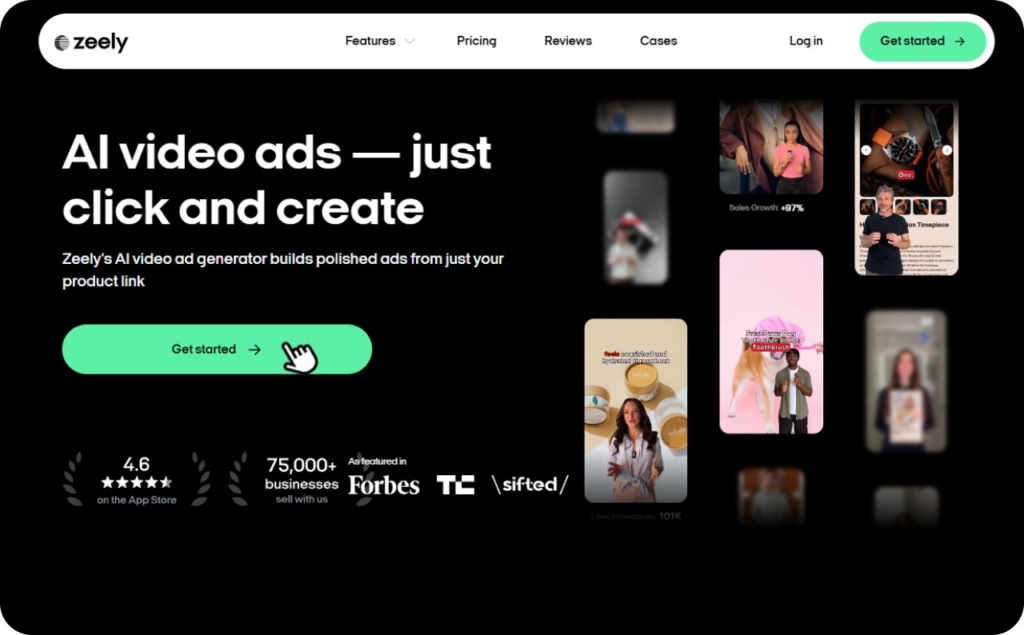
Keep your ads fresh and efficient at every stage
Rotate visuals every few weeks to avoid creative fatigue, especially in retargeting. Automate your edits with Zeely and focus on the bigger strategy. Monitor CTR, CPC, and CPM to ensure your workflow boosts efficiency, not just speed. Keep production lean so you can pursue ROI, not endless edits.
Conclusion and recommendations
You’re not just picking static ads or video ads — you’re shaping your campaign strategy. TikTok and Instagram Reels favor short videos, while static ads stand out on Facebook and Google Display. Choose static for speed and budget. Go with video for deeper engagement and top-of-funnel storytelling.
To optimize a campaign, clarify KPIs first. If ROI or direct sales lead your goals, start with static for a leaner approach. If brand lift or higher CTR is your priority, video may bring bigger rewards.
Next, assess resources. Video can demand more time or skill, but it often pays off in engagement. Static remains safe if you’re short on funds or team bandwidth. Finally, test and refine. Track CPM, CPC, and conversion rate. If a video goes over budget without boosting results, pivot to static. If static stalls, add motion or animation.
As your budget and campaign goals evolve, stay flexible. Start with static if that’s all you can handle now. Then layer in advanced video or dynamic creative formats once you see enough returns. Adapt to new platforms, cross-channel trends, and shifting audience tastes so you never fall behind.
Don’t wait. Pick a funnel stage, choose a format, and run a quick A/B test. Watch real data to see which approach brings stronger campaign optimization. Keep iterating. Each small win can lead to major ROI gains. That’s how you turn an ad decision into lasting success.
Also recommended



